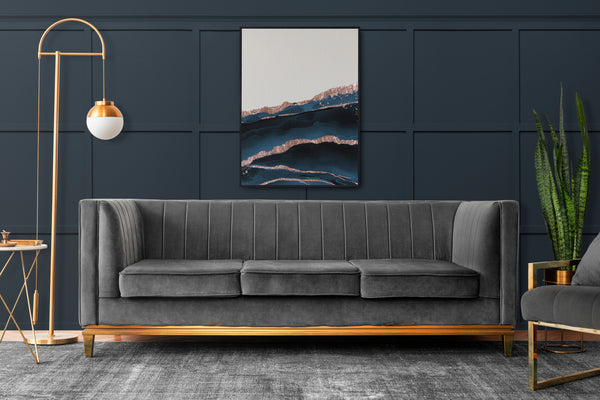How to Remove Old Water Stains from a Fabric Sofa?

TABLE OF CONTENTS
- Practice Guide To Remove Old Water Stains From A Fabric Sofa
- Start By Understanding The Problem
- Follow The Pre-Cleaning Steps
- 3 Different Methods To Handle Water Stains
- Why Should You Be With White Vinegar While Removing Water Stains From A Fabric Sofa
- Fabrics That Usually Tolerate White Vinegar (With Caution)
- Fabrics That DO NOT Go Well With Vinegar
- Some Extra Post-Cleaning Tips For Your Fabric Sofa
- When To Call A Professional?
- Final Words
When water spilled on your fabric sofa, did you panic? I bet you were kinda calm saying it's just water, right? Because it eventually will dry and won't harm. But then, you are now spotting rings and marks that make your sofa look old and worn out.
The good news is that not all hope is lost; with the right approach, the water stains can be safely lifted without damaging your fabric.
But the key is understanding that different fabrics react differently to water and cleaning solutions and that a careful, step-by-step method works far better than rushing in with whatever you have on hand.
In this guide, we will walk you through how to identify, treat, and remove water stains from your fabric sofa. So, you can easily restore it, leaving no evidence that such a mishap happened.
Practice Guide To Remove Old Water Stains From A Fabric Sofa
Start By Understanding The Problem

Before you start scrubbing or spraying anything at all on your fabric sofa, pause and try to comprehend why water stains appear in the first place.
When water gets on fabric, it can react with minerals in the water or leftover detergent from previous cleanings.
As the water evaporates, these minerals and residues stay behind, leaving those annoying white or darker ring-like marks.
Gather your materials
Before getting started, make sure you have the right tools. Using the proper materials keeps you from accidentally damaging the fabric.
What you will need:
- Clean white microfiber cloths or towels
- A spray bottle to control moisture levels
- Distilled water (not tap water)
- Mild dish soap or upholstery cleaner
- White vinegar(only for suitable fabrics)
- Soft brush and vacuum
Follow The Pre-Cleaning Steps
Before applying anything, take a few minutes to prepare:
Vacuum the sofa thoroughly to remove dust and crumbs. Dirt left behind can turn to mud when wet.
Check the care label. Look for one of these codes:
|
Code |
Cleaning Method |
Description |
|
W |
Water-Based Cleaner |
Fabric can be cleaned with water-based shampoos or foam upholstery cleaners. |
|
S |
Solvent-Based Cleaner |
Fabric should be cleaned with a dry-cleaning solvent; water may damage it. |
|
W/S |
Water or Solvent-Based Cleaner |
Either water-based or solvent-based cleaners are safe. |
|
X |
Vacuum or Brush Only |
Fabric cannot be safely cleaned with water or solvents. |
|
D (less common) |
Dry Clean Only |
Professional cleaning is required. |
Despite any type of cleaner you are using for your fabric, it’s best that you spot test any cleaner you plan to use on a hidden area (like the back or underside). Wait until it dries to ensure there’s no discoloration or damage.
This step might feel slow, but it can prevent costly mistakes.
3 Different Methods To Handle Water Stains
Method 1: Distilled Water Blotting For Light Stains

If your fabric has a faint water stain you may only need pure distilled water to even it out.
- Start with lightly dampening a clean cloth with distilled water and don’t soak it.
- Next, you can blot the water stained area gently. Start working from the outer edge toward the center to prevent spreading.
- Once the treated area feels evenly damp, leave it to air dry naturally. You need not use hair dryers or heaters for this.
- Now after some time, check the treated area for any mark. If it still lingers, repeat once more.
Why this method works: When you rewet the water stain using distilled water, it helps the residue dissolve evenly and hence the ring disappears as it dries.
Method 2: Mild Soap Solution (For Persistent Stains)

This method best suits persistent water stains. For example, even after you have used the distilled water method and you find the stains still hanging around, it’s best to try this method.
- If water alone doesn’t do the trick, we can level up a bit and try a gentle soapy mix.
- Start by combining 1 teaspoon of mild dish soap with 2 cups of distilled water.
- Next dip a clean cloth or a towel into the solution, wring out the excess water and try to blot the stain gently.
- Once the stain is removed, you can take another clean cloth and dip it in plain distilled
- water and clean again to remove any soap residue.
- As a final step, you can pat dry with a towel and let the sofa air dry fully.
Note: Using too much soap to clear the water stains can leave new marks, so it’s recommended to keep your mixture mild and don’t oversaturate the fabric.
Method 3: Vinegar & Water Solution (For Tough Stains)

If the water stain is stubborn or it has remained unnoticed by you for a long time, then you can start treating the stain directly with vinegar and get rid of the mineral buildup.
- Start by mixing equal parts white vinegar and distilled water.
- Next, take a clean white cloth and lightly dampen it with the solution and start gently blotting the stained area.
- After a few minutes, use a second cloth dampened with plain distilled water to rinse away any vinegar.
- Now leave the treated area to dry naturally.
Important: Avoid using vinegar on delicate fabrics like silk, wool, or velvet and it’s best that you stick to synthetics or tightly woven cottons.
Why Should You Use White Vinegar When Removing Water Stains From a Fabric Sofa?

We use white vinegar to treat stains on fabric because it's a natural, gentle acid that can help dissolve the mineral deposits or soap residue that's found on the stain. Plus, it's also effective at neutralizing odors and restoring brightness to certain materials without harsh chemicals.
However, you need to be cautious because vinegar's acidity can affect the fabric's structure, color, and texture, especially the delicate ones like silk, velvet, or wool. These materials can weaken, lose their sheen, or worse, change color when exposed to acidic solutions. That's why vinegar should only be used in small, diluted amounts on fabrics that go well with it. Also, test it in a hidden part first before proceeding.
Fabrics That Usually Tolerate White Vinegar (With Caution)
|
Fabric Type |
Vinegar Safety |
Notes |
|
Microfiber (polyester-based) |
Safe when diluted |
Gently blot. Don't soak. Rinse with distilled water afterward. |
|
Cotton (tightly woven) |
Usually safe |
Test for colorfastness first; can sometimes lighten dyes. |
|
Linen |
Use caution |
Natural fibers absorb easily and can leave water rings if over-wet. Use minimal moisture. |
|
Synthetic blends (polyester, nylon, acrylic) |
Safe in small areas |
Don’t over-wet; can leave streaks if not rinsed properly. |
|
Canvas |
Fairly safe |
Blot dry quickly to avoid water marks. |
Fabrics That DO NOT Go Well With Vinegar
|
Fabric Type |
Why to Avoid Vinegar |
|
Silk |
Vinegar’s acidity can weaken fibers and alter sheen or texture. |
|
Velvet (especially cotton or silk velvet) |
Water + vinegar can crush piles and cause rings. Needs dry cleaning methods. |
|
Wool or wool blends |
Vinegar can strip natural lanolin oils and cause rough texture or color changes. |
|
Rayon or viscose |
Extremely sensitive to moisture; vinegar can cause permanent water spots. |
|
Leather or faux leather |
Vinegar dries and cracks the surface over time. Use a pH-balanced leather cleaner instead. |
Some Extra Post-Cleaning Tips For Your Fabric Sofa

Once the water-stained area is clean and completely dry, now it’s time to restore the fabric's texture. If you ask if this step is necessary, well, know that sometimes cleaning the fabric can flatten its fibers or leave slight unevenness in the pile. So, to restore the fabric sofa, you can do the following:
1. Vacuum The Area Again
After drying the cleaned area, you may find some loosened dirt and soap residue remaining on the surface. Here, carefully vacuum in the direction of the fabric's weave to smooth fibers and lift the pile evenly. This small step completely erases the traces of water-strains.
2. Restore The Fabric's Pile Or Texture
Another simpler way to restore the fabric that has become flattened are:
Take a soft-bristled brush, a microfiber cloth, or a lint-free towel, and gently brush the fabric in one consistent direction while the area is completely dry. For microfiber fabric, you can use a dry sponge or a clean toothbrush if the treated spot is smaller.
3. Deodorizing Is Optional But Recommended
If you notice any lingering smell of the vinegar or soap used in the cleaning, you can sprinkle a small amount of baking soda over the area. Let it sit for 15 to 30 minutes. Vacuum thoroughly and absorb odors without adding more moisture.
When To Call A Professional?
If your fabric sofa label says “S” or “X”, or if your attempts to make the water stains vanish is getting worse, it’s better you get in touch with a professional upholstery cleaner. The experienced professionals might be equipped with the right tools, and pH-balanced products to handle different fibers safely. Remember that knowing when to stop can save your sofa from permanent damage.
Final Words
Removing any kind of stains, not just water-based, on a fabric sofa is seen as a delicate process. Though this is a delicate process, you need not panic. With the right approach, you can restore your fabric upholstery. To avoid creating new stains or damaging the fibers, you simply need to understand your fabric type, choose the appropriate cleaning methods, and handle the area gently.
To prevent future water stains, blotting the spills immediately with a clean, dry towel and considering a fabric protector spray or a slipcover are a few simple habits that can go a long way.





